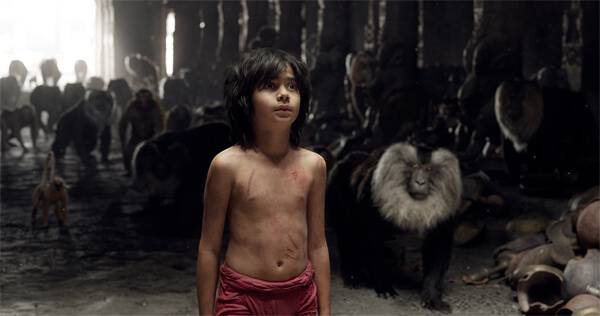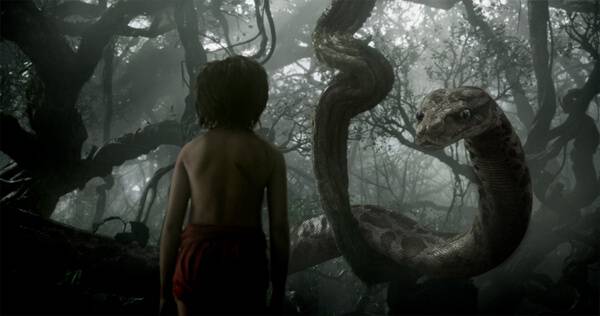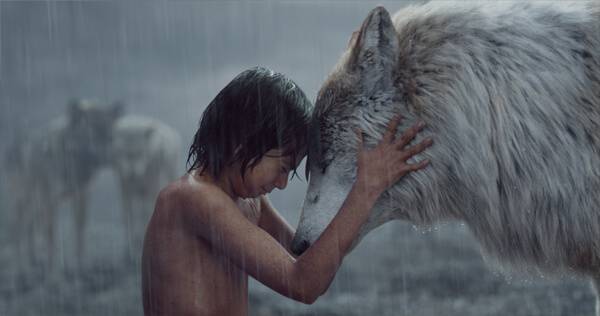Director Jon Favreau discusses Disney’s ‘The Jungle Book’ remake
This month sees the release of Disney’s reimagined The Jungle Book. This new iteration follows Disney’s recent tradition of adapting their most classic and iconic animated feature films to live-action/animation, with the latter supplied by industry powerhouses MPC and WETA. Skwigly contributor Johannes Wolters of INDAC spoke with director Jon Favreau (Elf, Iron Man, Chef) about tackling the project and the challenge of filling the shoes of the Wolfgang Reitherman-directed 1967 original.
I am not only very fond of the Disney movie from ’67, one of the very first films I saw in the cinemas as a child, but I also love the old Alexander Korda movie from ’42, which I saw on television many times.
Yes, the one with Sabu!
Yes indeed. So I was very anxious to see your new movie and I have to say: Congratulations, this is absolutely amazing!
So you feel like the people who grew up with the old movie, loving it so much, that it feels like it connects enough to the old movie for the German audience?
Yes indeed, very much. But this must have been very tough for you, being aware that there is the old Disney classic – or the old British movie with its hilarious plastic crocodile- to find your own voice and tone for the new movie?
I enjoyed it, because it is a bit of a puzzle. I welcome it, it is not something that frightens me, but it is something that, when you are done with it and you do everything that you think it is right, you do care what people think, you hope that your instincts are lining up with your audiences instincts because you can only make one person happy when you are working on it and that is really yourself. And you hope that in making yourself happy that translates to the rest of the world. And I, like you, I grew up with it, I was born in 1966, so that was one of the first movies I ever saw, I saw it over and over again! I loved the music, I loved the characters. But there was a bit of a balancing act, because the head of the studio, Alan Horn, grew up with the Kipling stories and, when I came on board, this movie resembled the Kipling stories much more then the Disney version.
They have been making live action versions of their old movies to a very good effect for the last few years, and I think that their instinct was to make it quite a bit older, without music. To me it felt like we are missing an opportunity because the music, the humour and the characters were important and we knew we could do a G-rated kids’ movie or musical like the original was. But I then felt there was a way with the photorealistic animals to bring something, a tone that felt in line with the tradition of Disney but was a bit more intense then the children’s cartoon, so we looked at movies like The Lion King which I think balance music and scariness and the idea that characters could die – which I don’t think was part of the ‘67 film, but it was very much part of the big five: Snow White, Bambi, Pinocchio, Fantasia and Dumbo, those had variations and tones where you had music and humor but you also had very scary villains. Walt Disney was not afraid to scare the audience, he felt that it was actually part of having a very full experience.

The Jungle Book (©Disney)
It is a tricky thing, making a photo-realistic movie. Even death can get real too!
Yes, that is why we needed to do things like keep the violence off-screen, because if you show your animals fighting each other too graphically, that would be just too much for this movie. 3D is also adding to this effect – 3D, Imax, it is loud and big and some of the sequences can be very overwhelming. That has been the balancing act here. But I have to say for me, personally, it does feel like there is a lot of cinematic impact from being photoreal, so I don’t think there was a real way to use that technology and these techniques and these designs to do a direct adaptation of the ‘67 film; I think that would have been very weird, because the characters were very cartoony and anthropomorphic and human and it wouldn’t have worked with the photoreal animals. So this is the balance that worked for me and fortunately people seem to responding well to it. They are certainly curious about it. But I am waiting to see what happens when the film comes out. I can´t wait to see what the reactions of the audiences will be.
I am pretty sure, that this will be a huge hit and I hope, there will be a part two. But I would love to speak about the songs – you kept three from the ´67 movie in your film.
Yes, I felt that those songs were a very big part of what I remembered and loved about the film. I did not want to keep all the songs – if you put too many songs in it, it becomes a musical and the tone shifts! I think that the sense of danger is an important part of it and I looked to the old Disney movies to see how they combine music with the intense moments and they used a formula that was also used in westerns. It was a more popular structure back in the earlier days of American cinema, which is you use it almost like a comic set piece or anything, you take a moment outside the movie to have a song. I felt that I had to include at least “I Wanna Be Like You” and “The Bare Necessities”. But I had to rework them a bit to fit into my story. ”Bare Necessities” fit in pretty well, but “I Wanna Be Like You” I had to treat differently and we had to change the lyrics. Fortunately Richard Sherman, who wrote the song originally with his brother, is still alive and working and he wrote some new lyrics for us to match our version of King Louie. And then “Trust In Me” – that Scarlett Johansson sings – happens in the end credits. So that did feel like the footprints of the old movie and every other musical reference we work in through the score. Our composer John Debney grew up on the Disney lot actually with Walt – when he was young his father worked on movies as early as Snow White, so his childhood was spent around the Disney lot. All the classics that we grew up with, he was actually there when they were making them as a little kid! So he was able to bring a lot of that tradition in, he has a deep understanding of the musical roots of that studio.

The Jungle Book (©Disney)
The musical intro to the Kaa sequence with the music of George Bruns is absolutely stunning!
Thank you! Also in the very beginning of the movie too, we play sections from the original score, so we really wanted to embrace it. These are the little things and since you are such a fan, at the end you noticed the book that closes?
Yes I saw that, what a wonderful idea!
It is the same book! We found it in the Archives! And I had to ask over and over again at Disney, they said “You can´t handle the book, this is like a museum piece!” We got them to bring in the Archivist wearing white gloves and, of course we could have done the book digitally but when the book closes at the end of the movie it is the same exact book that opens up in the beginning of the first Jungle Book! So to me it felt like they never closed the book on their movie. The movie ends without the book, and our film ends with our book closing.
By the way, the opening logo with the castle? That is actually is a hand-painted multi-plane cel animation like they did in the old days. So it is like we start with a practical effect and we end with a practical effect. And everything else is just digital except for the boy!
Of course we have to speak about Rob Legato and all the hundreds of artists and animators who did all this wonderful stuff.
Yes, I wanted to work with Rob for a long time, he has done it all! I love what he did with Hugo also, it was so wonderful. And another thing about Rob is, when he does designs for 3D, it does not feel like you are just being charged to pay more money to go to see the same movie. It feels like the 3D experience is actually an added value. I felt the same with Avatar and have not felt that many times since. In designing the shoots and the movement, he has a cameraman’s mind even though he is a VFX genius.
Credit also has to go to all the people who worked under him and with him from the facilities: MPC, the London facility, they did tremendous work, Adam Valdez is the supervisor from there, WETA did the whole King Louie sequence and it is the animators who are adding all the performance even though we used motion capture and video reference; these movies are handmade films. Even a motion capture movie you hear so much about, there are hundreds of artists whose jobs it is to make that captured data and that animation look like it is real and they are breathing their own humanity and their touch into it. And that is what it brings it to life! This was something I did not understand completely when I started this, I’d worked on VFX movies before but never so closely with the artists. I was assuming that the computers were doing a lot of the work but really the computer is just a tool! Just as the paintbrush was back then when they were doing cel animation. It is really the level of taste and the craftsmanship and the artistry of these people who are working behind the scenes and bringing all this to life. You know, if you sit through all the songs in the end credits, there are more than 2000 names there. It has never been a more human medium as it is now. Don’t let the technology fool you!
So what kind of movie is it? It is not a live action movie and also it is not really an animated movie, or is it?
It would qualify for either! You know, every shot is animated, so there is as much animation in this film as in every other animated film. I think the aesthetics shifts so, because you have a live action character in the center of it, it appears to be live action if we are doing our job right. And as a result, I think, most people would consider it live action! But honestly the line is blurring so much between the two, especially with a film like this, you can call it either one.

The Jungle Book (©Disney)
It is amazing how Neel Sethi is selling this aspect to me while watching him interact with the animals.
The kid is doing a great job acting, but also there is this level of interactivity that you have not seen before. There are shoots, most people won’t notice: Mowgli is running his fingers through the fur of the wolf, that is extremely difficult to do! We picked a half dozen moments where there is direct contact between digital and practical elements and those are generally what you shy away from! Even a film like Avatar doesn’t really show that, either directly interacting or having a real character and a digital character share a frame which is a much higher standard than in a completely animated film.
So it seems nothing is impossible anymore?
I wouldn’t go that far! I think that I have done well with Visual Effects because I have not asked more of it then it is capable of, but I would not mess with a human face yet. That is the one thing where we are just too good in reading a human face. It will happen soon. But I would not trust it yet.
But storytelling is open for new frontiers?
Oh yeah – Gravity made me think I could do this! It could not be more different as far as what the setting is, but your imagination begins to open up, and that is the way cinema has been developing for a century: You have a filmmaker who has an idea of a story they want to tell, then people are working with him and figuring out together what piece of equipment and techniques to develop, to tell that story. Then the next filmmaker sees that technique and that inspires them to tell a different story so they wanna do something that nobody knows how to do and they invent a new way to do that!
It is amazing how it comes always back to a hero with a thousand faces…
Yes, exactly. Joseph Campbell is who Lucas would reference and I learned about him through that and it has become my playbook. Part of how we deviated from the ‘67 movie was how to make it more mythic, and Kipling’s mythology dates back even further then the 100 years ago that he wrote it, it goes back to Romulus and Remus, very old myths that crossed many cultures. I think now, when you are telling a story that has to circumnavigate the entire globe and every culture has to be able to relate to your story, the myths are a very respectable way to accommodate that market, because every culture relates to the old stories. It is part of who we are as a species and our connection to nature is something that mythology contends with. That is one of the primary concerns of mythology: it is connecting man to nature. So Jungle Book lends itself very effectively to that and I think Kipling and his writings really reflected that as well. I think that is part of the upside of taking liberties with the ‘67 version is having it hark back to something that is enduring. Certainly Disney understood the benefit of taking old stories, folklore, fairy tales from different cultures and then use the cutting edge technologies of his day to tell those stories in ways that were incredibly compelling; that is why it stands the test of time. The artistry and technology combined with the old myths is something that seems to connect with people in a very, very deep way!
The German version of this interview was originally featured on the animation blog INDAC.
Disney’s The Jungle Book is out in UK cinemas now. Visit disney.co.uk to learn more.

